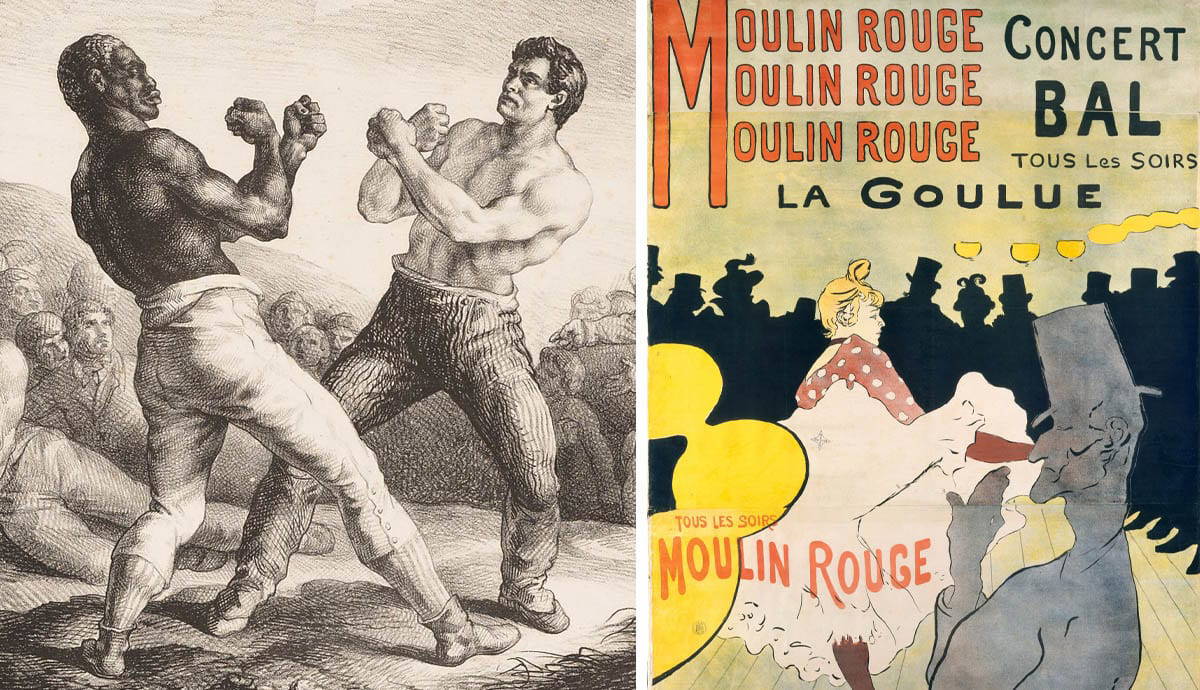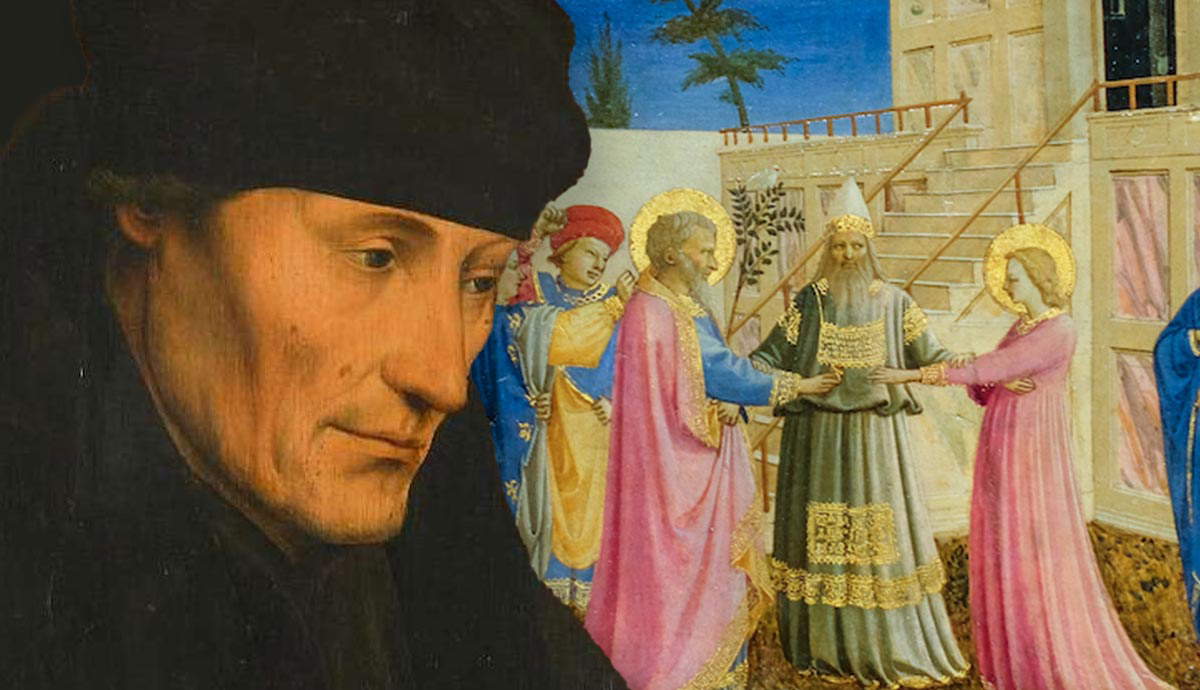
Invented in 1796 by Alois Senefelder, lithography is a form of printing. The power behind lithography is the relationship between water and oil. The required equipment and technique needed to create lithographs was difficult to acquire, but the process was slowly improved throughout the 19th century, with its popularity soaring in the 1870s. From then on, many different artists from many different art movements utilized the medium to produce their own famous lithographs. Here are ten that you need to see.
Famous Lithographs Of The 19th Century
Boxers By Théodore Gericault

Many know Théodore Gericault for his incredibly famous work, The Raft of Medusa, which hangs in the Louvre. Although his talent with oil was apparent, he was also a master of lithography. In his work, Boxers (Boxeurs), we see two men, one black and one white, in a boxing match. He emphasizes contrast throughout the work, even with the different techniques he used to create different parts of the work. For the darker areas of the print, such as the upper half of the black boxer and the pants of the white boxer, he used a sharp pen and ink lines. The torso of the white boxer and the pants of the black boxer were created with soft crayons.
The Races (Les Courses) By Édouard Manet

The famous modernist painter Édouard Manet experimented with creating lithographs during the early 1860s. While many artists preferred to hire trained artisans to create prints of their works, Manet favored producing the prints himself. Many of his lithographs were directly reproduced from the originals, resulting in reversed versions of them. Like with many of his works, we are given a unique perspective rather than the typical depiction of horse races from the stands.
Poster Lithographs
Moulin Rouge: La Goulue By Henri De Toulouse-Lautrec

Henri de Toulouse-Lautrec was an avid attendee of the Moulin Rouge in Paris when it opened in 1889. He was commissioned by Charles Zidler, one of the co-founders of the cabaret, to create this large poster. After his success with Moulin Rouge: La Goulue, Toulouse-Lautrec continued to create posters until his death in 1901. He liked the accessibility to the public his posters allowed in comparison to paintings. His famous lithographs could be seen all over Paris and were especially eye-catching due to their emphasis on imagery and less on large bodies of text. In this work, we see the famous can-can dancer Louise Weber, who went by the stage name of La Goulue.
Americans All! By Howard Chandler Christy

Howard Chandler Christy was a well-known portrait painter. From the 1920s to the 1950s, he painted numerous different presidential portraits and celebrities during this period. Besides his successful portraiture career, he was also a well-established printmaker. He created dozens of famous lithographs promoting recruitment for WWI. Some of his most recognizable works include a “Christy Girl,” a young, educated, woman who navigates the modern world with newfound freedom. Christy was married twice in his life to women who modeled for his “Christy Girl” works.
Famous Lithographs Of The 20th Century
Emiliano Zapata By Diego Rivera

Diego Rivera was a Mexican muralist painter who strived to preserve and share Mexican history through his work. He spent time in Italy studying frescoes and returned to Mexico where he began producing frescoes in monumental buildings such as the National Palace in Mexico City and the Palace of Cortés in Cuernavaca, which holds the fresco that contains the first appearance of this famous scene. In 1931, Rivera was invited to New York to create portable murals to be put on display at the MoMA and this scene again appeared in one of the five works he produced. The popularity and controversy that surrounded the heroic depiction of Emiliano Zapata lead to the creation of prints of the scene.
Relativity By M.C. Escher

M.C. Escher was a Dutch graphic artist who used mathematics to create impossible worlds in his works. Scientists and mathematicians showed more interest in his works than the art world did, initially. In the late 60s, his works began appearing on album and book covers. His balance between the chaos of a world our brains tell us is unfeasible and the calmness of its inhabitants emphasizes the Surrealism of the work. His use of three-point perspective eliminates what is up and what is down and creates a difficult situation when it comes to lighting. Escher tackles this issue seamlessly by carefully analyzing where light would come from and how it would affect the work from each of its horizon lines.
Modern Lithographs
Marilyn Monroe I Love Your Kiss Forever Forever By Andy Warhol

Andy Warhol is a highly renowned artist and his works that feature Marilyn Monroe are some of the most popular and distinguishable in the world. Here we have a unique lithograph he made as a contribution to Walasse Ting’s book 1¢ LIFE, an incredible collection of Ting’s poetry and lithographs from 28 different artists. Warhol’s lithograph features Monroe’s lips, a highly recognizable attribute of the famous movie star. His depiction of her lips almost mimics that of an ad, as if her lips were a mass-produced product for the public. Along the bottom of the lithograph is one of Ting’s poems titled Jade White Butterfly. His use of Pidgin English reflects on the past style of Beat poetry.
Explosion By Roy Lichtenstein

One of the Pop Art movement’s most famous members, Roy Lichtenstein has one of the most recognizable styles in all of the art world. He created bold works of art inspired by advertisements and comic books. Explosion features Ben-Day dots, named after their inventor Benjamin Henry Day, Jr. They were a popular technique with printmakers for creating shading and coloring. Lichtenstein represented the nuclear war fears that were rampant during this era. Nuclear bombs and explosions were prevalent throughout media during this time and Lichtenstein included their powerful message within in his own work to connect with his audience.
White Line Square IV By Josef Albers

As much as Josef Albers did for the Minimalist and Op Art movements, he also made incredible strides in the world of art education. He was a member of the Bauhaus in Weimar, Germany until it was forced to close due to the turbulent political situation created by the Nazis. He emigrated after its closure to America and taught at Black Mountain College in North Carolina and then eventually was the head of the design department at Yale University. He created his simple, yet recognizable lithographs while exploring the optical effects of color and geometric shapes. He took the creation of these works very seriously, viewing them as scientific experiments with color theory.
Autobiography By Robert Rauschenberg

Robert Rauschenberg was another giant in the Pop Art movement. The use of mass-media images had been an important element within his work since the mid-1950s. He created his “combine paintings” to break down the barrier between life and art. Autobiography is an offset lithograph depicting different components of his life. The top panel features an x-ray of Rauschenberg himself and his astrological chart. The second panel is centered around a photo of himself when he was 2 years old with his parents. The third panel is a still photo captured of Rauschenberg during a performance he choreographed titled Pelican. Along with the many other elements in the work, the story of Rauschenberg is presented in a very fitting fashion. This work is able to be displayed vertically or horizontally. When presented vertically it stands at sixteen and a half feet tall.










